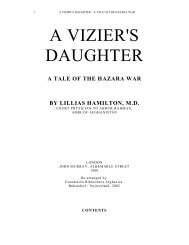The Inquiry into the History of the Hazara Mongols of ... - Hazara.net
The Inquiry into the History of the Hazara Mongols of ... - Hazara.net
The Inquiry into the History of the Hazara Mongols of ... - Hazara.net
Create successful ePaper yourself
Turn your PDF publications into a flip-book with our unique Google optimized e-Paper software.
HAZARA MONGOLS 237<br />
joined in Turkestan by troops under Chin Timur, <strong>the</strong>n governing Khwarezm<br />
for <strong>the</strong> family <strong>of</strong> Juchi, eldest son <strong>of</strong> Chinggis Khan. While <strong>the</strong> main army<br />
proceeded against Jelal ud-Din, Chin Timur remained in Khorasan as governor<br />
<strong>of</strong> that province.36<br />
According to Minhaj ud-Din, a second army was sent by Ogotai towards<br />
Ghazni under a leader called Mangutah, who was given control over Tokharistan,<br />
Kunduz, and Talikan, that is, <strong>the</strong> nor<strong>the</strong>astern portion <strong>of</strong> Afghanistan.37 A force<br />
was also dispatched to Herat and <strong>the</strong>nce to Sistan, and after <strong>the</strong> accession <strong>of</strong><br />
Ogotai to <strong>the</strong> throne, Tair Bahadur, leader <strong>of</strong> <strong>the</strong> Sistan troops, was ordered<br />
to proceed to Ghur and Ghazni.38 This army must have remained in <strong>the</strong> region,<br />
for Minhaj ud-Din writes39 that<br />
<strong>the</strong> territory <strong>of</strong> Ghaznin, and Karman, remained in <strong>the</strong> hands <strong>of</strong> <strong>the</strong> Mughal<br />
Shahnahs [Intendents], until <strong>the</strong> year 639 H.,40 when <strong>the</strong> Mughal forces, and <strong>the</strong><br />
troops <strong>of</strong> Ghur, were directed to advance to Lohor.41<br />
When Mangu Khan ascended <strong>the</strong> imperial throne in 1251 it was decided in<br />
<strong>the</strong> imperial quriltai that Mangu's bro<strong>the</strong>r, Hulagu, be sent to Iran at <strong>the</strong> head<br />
<strong>of</strong> a major expedition.42 Hulagu, who arrived in <strong>the</strong> west in 1256 AD, gave<br />
his attention to <strong>the</strong> conquest <strong>of</strong> <strong>the</strong> Ismaili in northwestern Iran, <strong>of</strong> <strong>the</strong> Muslim<br />
Caliphate at Baghdad, and <strong>of</strong> Syria, but did not concern himself with Afghanistan.<br />
Indeed, at <strong>the</strong> coronation <strong>of</strong> Mangu Khan <strong>the</strong> whole territory extending<br />
from Herat to <strong>the</strong> Indus was given in appanage to a descendant <strong>of</strong> <strong>the</strong> Tajik<br />
dynasty which had ruled Ghur prior to Chinggis Khan's invasion.43<br />
Hulagu's successors, <strong>the</strong> Mongol Ilkhans <strong>of</strong> Iran, made little attempt to<br />
bring <strong>the</strong> area now known as <strong>the</strong> <strong>Hazara</strong>jat under <strong>the</strong>ir control. Khorasan, <strong>the</strong><br />
nor<strong>the</strong>astern province <strong>of</strong> Iran, was traditionally administered by <strong>the</strong> heir to <strong>the</strong><br />
Ilkhanate, and <strong>the</strong> Badghis region, just north <strong>of</strong> Herat, was a favorite headquar-<br />
36 d'Ohsson, vol. 3, pp. 47, 103; Minhaj-ud-Din, vol. 2, pp. 1109-10. Although Chin<br />
Timur was himself a Turk, he is reported as being assisted by four representatives <strong>of</strong> <strong>the</strong><br />
family <strong>of</strong> Chinggis Khan (Howorth, vol. 3, p. 15). As d'Ohsson points out, <strong>the</strong> Mongol troops<br />
inherited by Chinggis Khan's sons as part <strong>of</strong> <strong>the</strong>ir appanages formed only a nucleus <strong>of</strong> <strong>the</strong>ir<br />
armies, which were recruited chiefly from peoples native to <strong>the</strong> appanage (d'Ohsson, vol. 2,<br />
pp. 5-6, footnote). In <strong>the</strong> thirteenth century <strong>the</strong> population <strong>of</strong> Transoxiana was largely Turkish.<br />
37 Minhaj-ud-Din, vol. 2, p. 1109.<br />
38 Idem, vol. 2, pp. 1119-26. According to Minhaj-ud-Din this army reached Sistan in<br />
625 AH (1228 AD), that is, before <strong>the</strong> coronation <strong>of</strong> Ogotai.<br />
39 Idem, vol. 2, pp. 1131-32.<br />
40 1241 AD.<br />
41 In India.<br />
42 d'Ohsson, vol. 3, pp. 134-135.<br />
43 Idem, vol. 3, pp. 129-131.



